At the beginning of January 2022, Kazakhstan was shaken by a series of protests against the elimination of fuel price caps. The unrest started in the city of Zhanaozen, whose economy is based on oil, and then spread across the country, eventually reaching the former capital and most populated city of the country, Almaty.
President Kassym-Jomart Tokayev authorised police forces to use guns and violence to repress protesters. The president also asked the Russian army to intervene, in order to suppress what has been defined as an ‘attempted coup’ which shows ‘foreign interference’.
We have analysed this delicate geopolitical situation with Paolo Sorbello, a journalist and research grant holder at Ca’ Foscari. Dr Sorbello has been living in Kazakhstan for 5 years and is currently working on a research project that focuses on the relations between the country and the powers that surround it, Russia and China. Dr Sorbello’s project, which is supervised by Professor Aldo Ferrari, aims to explore some relevant issues in contemporary Kazakhstan, and in particular the ways in which internal politics and the economy influence the country’s relations with its powerful neighbours.
The year 2022 started with the doubling of the price of LPG, which brought underlying tensions to a breaking point. Which events led to this crisis, and how did the protests start?
The recent protests in Kazakhstan are chiefly related to inequality. Since the country’s independence, Kazakhstanis have been politically and socially marginalised and forced to respect the rulings of a leading class which lacks legitimacy.
The fuse that lit the protests was the already mentioned rise in the price of LPG, which is important in the western region of Mangystau, but not that relevant in the rest of the country. Therefore, the causes of these protests are to be found in the dissatisfaction that the people of Kazakhstan feel towards the ruling class.
The ex-president Nursultan Nazarbayev led the government for 28 years, and during this time the opposition was weak — while it attacked the president on a personal level, it never truly represented a viable political alternative for the people.
The people of Kazakhstan were relieved when Mr Nazarbayev passed the baton to Kassym-Jomart Tokayev in 2019. However, their hopes for systemic change were soon dampened. In fact, one of the new president’s first moves was to rename the capital Astana “Nur-Sultan”, to honour his predecessor and mentor. Any promise of change has been broken.
Between former president Nazarbayev and his “dauphin” Tokayev, the current president, things used to seem pretty smooth. How did the accusations of high treason and the government crisis come about?
During the last three years Kazakhstan has lived in a sort of interregnum period, one in which Mr Nazarbayev and President Tokayev have clashed only on decisions regarding the moving of “pawns” inside the élites that are close to the government. However, it was never a systemic dichotomy. The vision of the government of Kazakhstan has always been the same.
One of Tokayev’s first moves after the start of the unrest at Almaty was to fire the chief of intelligence, Karim Massimov, a powerful man who was close to Mr Nazarbayev, Two days later, Mr Massimov was arrested and accused of high treason, for having supposedly orchestrated the protests. Even Mr Nazarbayev, who after renouncing the role of president had fashioned himself a role as Chief of the National Security Council, has been dismissed.
Mr Tokayev claims that there has been an attempted coup by armed forces that are partially organised by people inside the establishment. Some people fear that this “soft” dichotomy will lead to a sort of civil war — however, this is an untenable hypothesis for a variety of reasons. To begin with, there is no reason why Mr Nazarbayev would be interested in regaining control of the country with a coup, since he has never really relinquished his influential position in the government.
On 5 January, President Tokayev appealed to a Russian-led military alliance - the Collective Security Treaty Organization (CSTO) - a sort of NATO that includes various post-Soviet countries. What are the implications of the involvement of the Russian troops?
The involvement of Russian peacekeeping forces is crucial — it is CSTO’s first intervention since 1994, the year in which it was founded. The Treaty works in a way which is similar to NATO’s, with the consent of the member states and when there are foreign attacks.
Therefore, President Tokayev’s initial claims of high treason and of an internal coup turned was substituted by claims according to which 20,000 terrorists trained in the Middle East attacked Alamaty to upturn the government. An attempted coup carried out by foreign forces was the reason that justified the activation of CSTO.
President Vladimir Putin, who has always maintained good relations with Mr Nazarbayev and President Tokayev, responded immediately. In this way, Tokayev will not only benefit from the support of the Russian president, but also from that of all the other presidents of state involved in the treaty — this means that Tokayev can safeguard his role as Kazakhstan’s “man of the future”.
CSTO member states have expressed their support for the president of Kazakhstan, electing him as defender of the country’s stability. President Tokayev has become stronger, having obtained a regional warranty from a military perspective. From a political perspective, President Putin knows that Russia can count on a grateful ally.
For what concerns the remaining geopolitical figures who have an interest in this part of the world, the primary relationship between Kazakhstan and Russia has been regarded positively, and the intervention of CSTO forces has reassured China and European countries.
There has been much talk about the role of bitcoins in the crisis. Did cryptocurrency actually play a decisive role?
Bitcoins were not among the causes of the protests, but they have suffered the consequences. Kazakhstan is the second largest bitcoin miner in the world. Cryptocurrency is “mined” from calculators which use electricity, and 70% of that electricity is fuelled by coal power plants that are not related to LPG, nor to the area in which the unrest originated.
When China banned mining within its borders, many bitcoin producers moved to Kazakhstan, where energy costs less. This caused an overload of the electricity grid, with blackouts and problems in the coal power plants — but even this was not enough to cause a popular uprising. In fact, cryptocurrencies do not have a significant impact on Kazakhstan, neither in terms of employment nor of budget.
However, people who possess bitcoins have seen the value of this cryptocurrency decrease over the last few weeks, not really because of the protests, but because of the internet shutdown that lasted 5 days and was imposed by the government to facilitate security measures. Computers were disconnected from the internet and bitcoin production was interrupted. The general worry about the future of cryptocurrency led many possessors to sell it, which caused a depreciation of cryptocurrency.
Now that the protests seem to have been suppressed definitively, is the situation really under control? What are Kazakhstan's future prospects?
The emergency has been dealt with and the cities where people protested have been soothed. The Russian forces are retreating gradually, in order to avoid any brusque changes.
People who are as familiar with Kazakhstan as I am knew from the start that the Russian forces would retreat, while others feared that foreign forces would become constantly employed. What some people perceived as an invasion was nothing more than a token of reassurance on the part of close allies.
From now on, two particular issues will characterise the country’s future.
Firstly, President Tokayev’s new government. Even though during his speech at Parliament he attacked the élite of the rich and powerful, the system has not changed and is unlikely to change. Power will continue to be concentrated in the hands of the president and controlled by various influential groups.
Secondly, the suppression of civil and human rights. The government is already using an iron fist against journalists and civil right activists, and has imposed further restrictions on all expressions of freedom and on human rights. Following the protests, over 12,000 people have been arrested and many are still in prison. Among them there are many peaceful protesters and activists that have been arrested despite not being involved in illegal activities.











